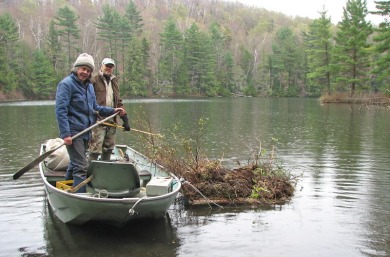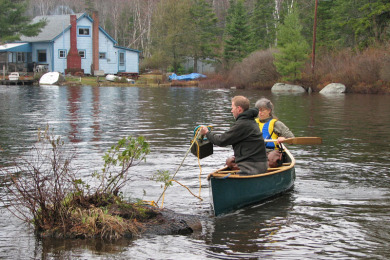VCE works with hydroelectric dam operators to stabilize reservoir levels during loon nesting season. On waters where levels do fluctuate, loons are finding success with “nesting rafts.” These floating nest sites mimic islands and help loons succeed.
 Nesting Rafts: Tales from Five Lakes
Nesting Rafts: Tales from Five Lakes
Rafts work, plain and simple. Why don’t we place them on any lake experiencing nesting failure or on lakes to “attract” nesting loon pairs? The philosophical discussion begins.
The VLCP’s official viewpoint, with loons now off the state endangered species list, is that a raft should be considered if a loon nest fails repeatedly over many years or if a first-time natural nest is located in a site of conflicting uses (e.g., on an active beach front). There are exceptions to these guidelines, of course. Benefits exist to having lakes without nesting pairs, especially large lakes, because both non-breeding and breeding loons can congregate on these lakes for feeding and socializing without as much risk of territorial battles.
The VLCP has placed some new nesting rafts for different reasons.
- Harvey’s Lake – Several previous nest attempts failed along the outlet channel (predation and/or flooding). A raft was placed in the only wind-protected section of undeveloped shoreline left on the lake. The loon pair has not utilized it yet, likely because the raft is located nearly a mile away from the previous nest site.
- Norton Pond – A first-time nest failed in 2008 (depredated by raccoons). A raft was placed in a nearby cove because of shoreline predators, a nearby island with an active camp, and most importantly, because moderate rain events often cause flooding because of the small outlet in the dam. Loons started nesting on the raft in early June, but the nest failed.
- Caspian Lake and Lake Rescue – Potential loon pair activity has been observed on both lakes for many years with no documented nest attempts, and most likely nesting spots are near cottages and active beaches. No loon activity has been observed near the rafts. More monitoring is required to determine whether each lake really has a territorial pair, thus more volunteers are needed to document loon activity on these lakes.
- Shadow Lake (Concord) – The loon pair had three failed nests near private camps in 2007 and 2008. The nest failures were most likely caused by flooding rather than disturbance, however. There are no suitable wind-protected and undeveloped coves, thus a raft was placed in a moderately exposed location away from people in 2008. The loons did not show any interest in the raft in 2008 or 2009. Fortunately, the 2009 nesting site was in a more remote location than the previous three sites, and it succeeded in hatching chicks in early July. This raft might be removed.
Rafts are not a sure thing to mitigate for shoreline development or flooding, but they are a useful management tool. In the early 2000s, more than 10 nesting rafts were removed after years of being repeatedly placed without loons ever using them. In most cases, no territorial loon pair was present and in some cases, good natural nest sites were available. It takes much time, effort, and funding to place, maintain, and monitor loon nesting rafts. Therefore, we’re careful about when and where to use them.

